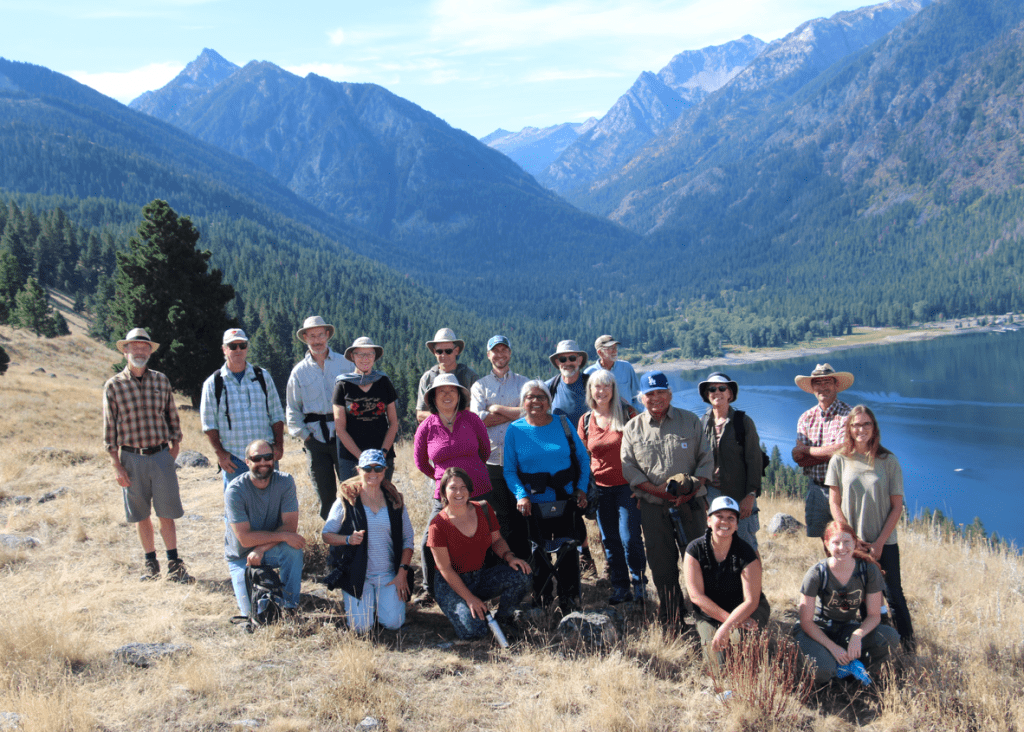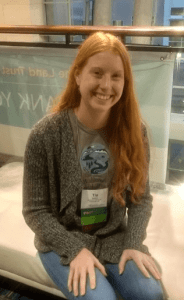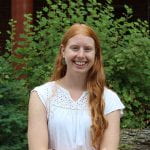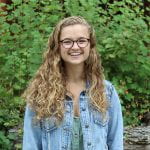By Tia Hatton, Outreach & Communications Coordinator, Wallowa Land Trust
It was my first Saturday on the job and the final day of my organization’s event series.
I woke up early, laced up my new hiking boots, and proudly wore my RARE T-shirt. After convening at the office around 8 am, I hitched a ride with five locals and a co-worker to the backside of the infamous East Moraine of Wallowa Lake. We drove south for fifteen minutes through the pastures to Joseph, turned east towards Imnaha, then turned right onto gravel roads through continued swaths of farmland that merge into forest. Being on that road reminded me I had been here before: nearly a year earlier, I went on a field trip to NE Oregon to listen and learn about the impact of Wolves on the people and the land.
The sun was shining bright as we gathered at the end of what seemed to be a dead end. A gate near us with a laminated green sign zip tied to the gate noted, “Do you want to see this landscape saved?” and the Land Trust and Moraines Partnership contact information. Three descendants of the Nez Perce Wallowa Band had joined us as our presenters, two of them elders. After brief introductions, we opened the gate, closed it behind us and started up the pebbly path dotted with budding ponderosa pines.
I met new folks left and right. I tried (keyword tried) to remember their names and connection to the Land Trust. Partners, board members, press, and community members joined the trudge up the steep backside of the moraine. That was the day I met my first RARE alumni, and in the coming months it would be at least three others. The morning chill wore off quickly as we rose in elevation and the sun beat down. I expectantly took in my surroundings while chatting with new partners and actively avoiding tripping.

The Land Trust and other local partners were currently trying to raise over $6.5 million to save this landscape. So, what was so special about this property? I sought to figure this out as we walked.
Surrounded by tall pines and firs, grasses, and glacial sized boulders, we walked up further to the top, having switchbacked northwest now. It was a massive property, nearly 1,800 acres. Sharp-pointed, clustered peaks caught my eye behind us: the seven devils mountain range. They’re about 30 miles due east in Idaho, but on a clear day like that, the Moraine has spectacular views of the peaks.
We rested under the shade of a tree at the top of one of the outer moraines at a flat area. I am told that at one point it was used for the first Chief Joseph Day Rodeo and an airport. This place had history, and one that went beyond the past 100 years. I was surprised at how difficult the hike was turning out to be – and perhaps more surprised to see the native elders making there way up to old road.
“We’re almost there,” someone commented. And we turned toward one last switchback.
Moraines are unique features created when glaciers sheer rocks off mountains and drop them in steep piles of gravel. Here in Wallowa County these moraines were created nearly 20,000 years ago. They are as we like to say “text-book perfect examples of moraines.” These massive slopes surround the iconic Wallowa Lake.
The development potential on the East Moraine was surreal – up to fifteen houses could be built, likely for the enjoyment of out-of-town second homes owners. Public access for the community would be cut off. For over ten years, Wallowa Land Trust has worked in partnership with local organizations and government to try to save this piece of property, keep it open to the public, and maintain historic forestry, grazing, cultural, and recreational uses.
After over an hour of hiking uphill, I had stopped fastidiously taking in my surroundings. As I walked up the final crest, I was simply ready to be done. But what I saw over the crest was one of the most incredible views I had ever seen.
I could see deep into the Eagle Cap Wilderness and Wallowa-Whitman National Forest: an endless vista of sharp granite summits and a sea of tree tops. Chief Joseph, the aptly named massive peak that takes up the entire background of the lake, looked exceptionally grandiose and red. The brilliant blue ribbon lake lay directly below us and the Wallowa River braided into the lake.

In that moment, in my attempt to perceive the stunning scene in front of me, I instantly knew why this landscape needed to be saved. Because it is one-in-a million.
Our group then sat down to listen to the Director for the Environmental Trust for the Colville Confederated Tribes about holistic resource management through the lense of a relationship with land – a relationship that considers sustainability for future generations and all living things. We listened to what it meant for a descendant of the Wallowa Band of the Nez Perce to be back on their traditional land.
We ended the long day back in Enterprise with a larger group of community members listening to the elders.
My job includes communicating about this incredible landscape and educating people to support and engage in our work as a land trust. This can look like designing a poster to solicit donations, event planning, press releases, newsletters, website updates, and much more.

Further, my job is to connect the Land Trust’s available resources and relationships with tribal members whose relationship to the County was frayed due to treaties. We are reaching out to them and offering what we can: access to privately owned lands thanks to willing landowners, knowledge of plants, travel resources, and hospitality. Overall, with the goal of offering a chance to further regain their sense of ownership of this place.
Even on the days when I am acutely aware of the fact that I live in the farthest corner of NE Oregon in a town of 1,900, I cherish working for a mission-driven, community-oriented organization with the tools to save incredible places that will be cherished for generations to come, especially in the face of climate change and growing development pressures.
The Moraines Partnership, including Wallowa Land Trust, has now raised enough money to purchase the East Moraine property and secure it for the enjoyment and use by generations to come.
 About the Author, Tia Hatton: Tia received her Bachelor of Science degree in Environmental Science and minor in Nonprofit Administration in June 2019. Born and raised in Bend, she has hiked, ran, and skied throughout the tremendous scenery and diverse environments of central Oregon. She’s worked on donor stewardship, outreach, and public lands monitoring for various Oregon nonprofit organizations. Tia is actively engaged in climate work with other young people through Our Children’s Trust legal action, Juliana v. US . She looks forward to applying and growing her nonprofit and land trust knowledge to benefit Wallowa County’s people and land, as well as fitting in many hikes.
About the Author, Tia Hatton: Tia received her Bachelor of Science degree in Environmental Science and minor in Nonprofit Administration in June 2019. Born and raised in Bend, she has hiked, ran, and skied throughout the tremendous scenery and diverse environments of central Oregon. She’s worked on donor stewardship, outreach, and public lands monitoring for various Oregon nonprofit organizations. Tia is actively engaged in climate work with other young people through Our Children’s Trust legal action, Juliana v. US . She looks forward to applying and growing her nonprofit and land trust knowledge to benefit Wallowa County’s people and land, as well as fitting in many hikes.
Does community development work interest you? Are you looking for a life changing experience in rural Oregon? Learn more about serving with the RARE AmeriCorps Program via our website: https://rare.uoregon.edu/application-process/member-application-process



